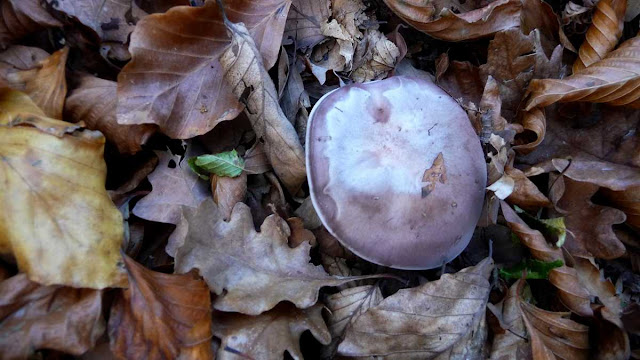Macrolepiota procera.
Macrolepiota is a genus of about 30 species of white-gilled mushrooms, three of which are very popular and sought after in Europe:
M. procera,
M. mastoidea and
M. rhacodes.
Macrolepiota procera, commonly known as the parasol mushroom, is one of the tallest mushrooms (15-30cm) that occurs in early fall, and probably the most widespread species in northern Greece. The large white cap is covered with patterns of dark flakes. It is egg-shaped when young and almost flat in maturity. The stem bears distinctive animal skin-like patterns and has a large ring that is not fixed on it. The white flesh has a sweet nutty smell. This is a maggot-free mushroom and the selected caps are easily preserved dried.
Macrolepiota mastoidea is a species very similar to
M. procera, with a distinctive nipple-like protuberance at the cap's apex. It is relatively smaller, with less obvious markings and not as widespread.
Macrolepiota procera, now known as
Chlorophyllum rhacodes, is a smaller species (up to 20cm high and wide) which is found growing in the shade. The dark patterns on the cap are scales cut deeper in the flesh, while the stem bears no markings.
Small species (2-8cm) belonging to the closely related genus
Lepiota are in their majority toxic mushrooms and should generally be avoided.
__________________________________________________________________
Το γένος
Macrolepiota (κοινώς Αδραχτίτες), περιλαμβάνει 30 περίπου είδη μανιταριών με λευκά ελάσματα, τρία από τα οποία είναι ευρέως γνωστά και αγαπητά στην Ευρώπη:
M. procera,
M. mastoidea και
M. rhacodes.
Η
Macrolepiota procera είναι ένα από τα ψηλότερα μανιτάρια (15-30εκ) που φυτρώνουν αρχές φθινοπώρου, και ίσως το πιο διαδεδομένο είδος στη Β. Ελλάδα. Το τεράστιο καπέλο καλύπτεται από σκούρες φολλίδες, και είναι αρχικά αυγόμορφο, ενώ στην ωριμότητα σχεδόν επίπεδο. Το πόδι έχει χαρακτηριστικά σκουρόχρωμα σχέδια, ενώ το μεμβρανώδες δαχτυλίδι είναι κινητό. Η σάρκα είναι λευκή με ευχάριστο άρωμα μανιταριού. Το είδος αυτό δεν προσβάλλεται από σκουλήκια, και τα αποξηραμένα καπέλλα είναι εύκολα στη συντήρησή τους.
Η
Macrolepiota mastoidea είναι ένας αδραχτίτης που παρουσιάζει μεγάλη ομοιότητα με την
M. procera, με μια χαρακτηριστική σαν θηλή προεξοχή στην κορυφή. Είναι είδος σχετικά μικρότερο, με με λιγότερο έντονα σχέδια στο πόδι και όχι τόσο διαδεδομένο.
Η Macrolepiota procera, γνωστή σήμερα ως
Chlorophyllum rhacodes, είναι ένα μικρότερο είδος (έως 20εκ ύψος και διάμετρο), το οποίο προτιμάει τη σκιά. Τα σκούρα σχέδια στο καπέλλο είναι φολλίδες βαθύτερα χαραγμένες στη σάρκα, ενώ το πόδι δεν έχει καθόλου σχέδια.
Τα μικρά μανιτάρια (2-8εκ) που ανήκουν στο συγγενές γένος
Lepiota, είναι στην πλειψηφία τους τοξικά και πρέπει γενικώς να αποφεύγονται.
The last images are of Macrolepiota rhacodes.





















































